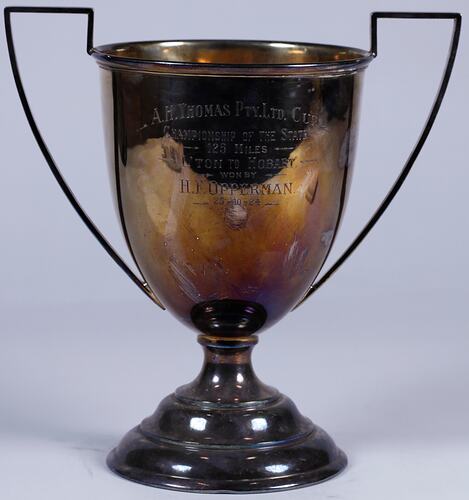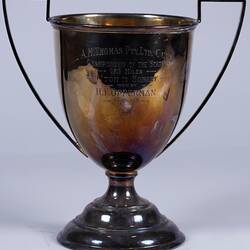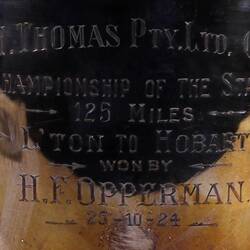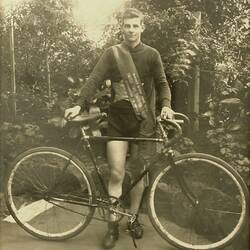Summary
A cycling trophy presented to Hubert Opperman for winning the Dunlop Road Race from Launceston to Hobart (125 miles) on the 25th October 1924. This was the second most important cycling race in Australia (after the Warrnambool to Melbourne) and attracted a high calibre of cyclists from all over Australia.
In contrast to when he first contested this route as a promising 18 year old youth in 1922 (Barnet Glass Road Race, Launceston to Hobart), Opperman had by this time demonstrated many stellar race performances and was being hailed as "one of the greatest road riders in Australia." He was also coming into this race as Australasian road race champion for his fastest time win in the Warrnambool to Melbourne race (165 miles) on the previous weekend.
Like many road races in Australia at the time, the race was conducted as a handicap with riders given a handicap time by officials according to their perceived ability. This allowed weaker or less experienced riders to be given a 'head start' in the race with the view that as the race progressed, the stronger riders would eventually catch the front riders towards the finish. In the field of 23 starters for this race, Opperman was given the 'scratch' mark handicap, along with J. Watson, Ernest Bainbridge, and Percy Osborn, and there was an 80 minute head start given to the 'limit' rider.
In an interview prior to the race Opperman said: "This is my third visit to Tassy, and I have secured fastest time on two occasions, but this year I am after Jack O'Farrell's record, and I think I can do it."
Opperman won the race in a time of 5 hours and 59 minutes, breaking O'Farrell's course record by just 10 seconds, and also earning a bonus prize of £20 which had been offered by Mr W. A. Lake to any rider who completed the event in under 6 hours. He was presented with the A. H. Thomas Cup by Mr George Watt and with the Blue Riband sash by the Tasmanian State Premier, the Hon. J. A. Lyons.
In Opperman's autobiography (Pedals, Power & Politics, 1977), he reflected on his encounter with Hon. Joseph Lyons, who later became Prime Minister of Australia (1931-1939), and who had presented him with his trophy. "It was a valuable hint to me during my later political days that young people, flushed with success and fatigued by exertion are not overly conscious of the most dignified and outstanding public figures, so that a short speech at the time, and a longer congratulatory letter afterwards, will leave a more lasting impression."
In total he won £70 in cash and trophies to the value of £21 3s which was made up of the following: for first prize, £41 5s (£25 cash and A.H. Thomas Cup , valued £10 10s); a B.S.A. repeating rifle donated by D. V. Rennie of B.S.A. Co. Victoria (valued £5 15s); £20 cash donated by Mr W. A. Lake for breaking 6 hours for the journey; £5 cash for fastest interstate competitor; £10 10s cash donated by Dunlop Rubber Co; £5 cash donated by Mr W. Goldsmith; and £4 10s for overall fastest time, and blue riband and badge (value £5).
In an interview after the race, Opperman described it as the "hardest race of his career". He thought it much worse than the Warrnambool, with a heartbreaking finish on a hilly course and on awful roads that were very rutted and caused excessive vibration for the riders. He acknowledged the bad luck that had been experienced by the second placed rider, R. Stamford (the Tasmanian champion) who had suffered several punctures along the way. It was also the first time Opperman had raced on a free wheel bicycle, made by his trainer Bruce Small - a Malvern Star, with 77-gear and fitted with Dunlop skin-side tyres.
There was much excitement at the finish and around 3,500 spectators; Opperman was carried from the track on the shoulders of the crowd. With that victory, a newspaper reported that "There is not the least room for doubt that this slightly built youth is the greatest road-racing cyclist Australia has ever produced".
Physical Description
Cup trophy with two handles. Silverplated over an alloy of copper, zinc and nickel. Handles are straight lined at the top but curve along the sides to the base of the cup.
More Information
-
Collection Names
-
Collecting Areas
-
Acquisition Information
Cultural Gifts Donation from Sir Hubert Opperman, Jun 1979
-
Acknowledgement
Donated under the Australian Government's Cultural Gifts Program by Sir Hubert Opperman.
-
Awarded To
Mr Hubert F. Opperman, Hobart, Tasmania, Australia, 25 Oct 1924
-
Sponsor
-
Inscriptions
Engraved: ' A.H. THOMAS PTY. LTD. CUP. / CHAMPIONSHIP OF THE STATE / 125 MILES / L'TON TO HOBART / WON BY / H.F. OPPERMAN / 25-10-24 ' Maker's mark, on base: ' [S in Star over a boomerang] [Half crescent moon over star] ' EPNS S&S / MADE IN AUSTRALIA / 101'
-
Classification
-
Category
-
Discipline
-
Type of item
-
Overall Dimensions
25.5 cm (Height), 25 cm (Outside Diameter)
-
Conservation
153 mm (Length), 250 mm (Width), 257 mm (Height), 0.7 kg (Weight)
Measurements from Conservation
-
Keywords




